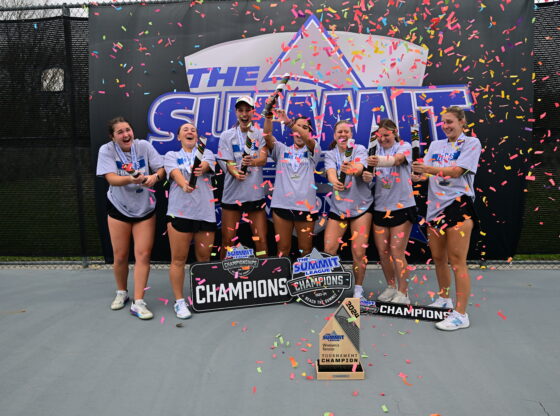To view a series of photos from this protest, click here.
Friday, Sept. 26—Outside of Mary Reed Hall, a swath of red covers campus. Protestors, within and outside the DU community, wear the color in solidarity with #NoMorePios. Together yet six feet apart, they brandish picket signs and COVID-19 kits. They are a community of people who acknowledge the pandemic but know radical change cannot be stalled or delayed.
“Chancellor Haefner, does this look like a select group to you?” a sign reads.
The group is 50, 100, then 200 activists strong by noon. They await guidance from the organizers—an unofficial student group known as Righteous Anger! Healing Resistance! (R.A.H.R.). The Instagram page went live merely 20 days before. But already, their supporters ‘roar’ the name.
The demands that drove the protest are far from new. The call to remove DU’s ‘Pioneer’ moniker has been made since the ‘80s to no avail. It is a term nostalgic to white alumni who cling to their alma mater, but traumatic to present Native students and people of color.
As fourth-year Hayden Evans, one of the R.A.H.R. organizers, explains: “[Pioneer] glorifies people who were complicit in the genocide and stealing of land from Native peoples. It reinforces intergenerational and personal trauma. For Native students on campus, they feel distant from the rest of the DU community. Why would they take on an identity that serves to harm them?”
For the privileged, ‘pioneer’ may be defined as innovation or exploration. For the historically-oppressed, it is synonymous with ‘colonizer.’ Among other acts of violence committed against the Native community, it is a harrowing reminder of the role John Evans—one of DU’s founders—played in the Sand Creek Massacre.
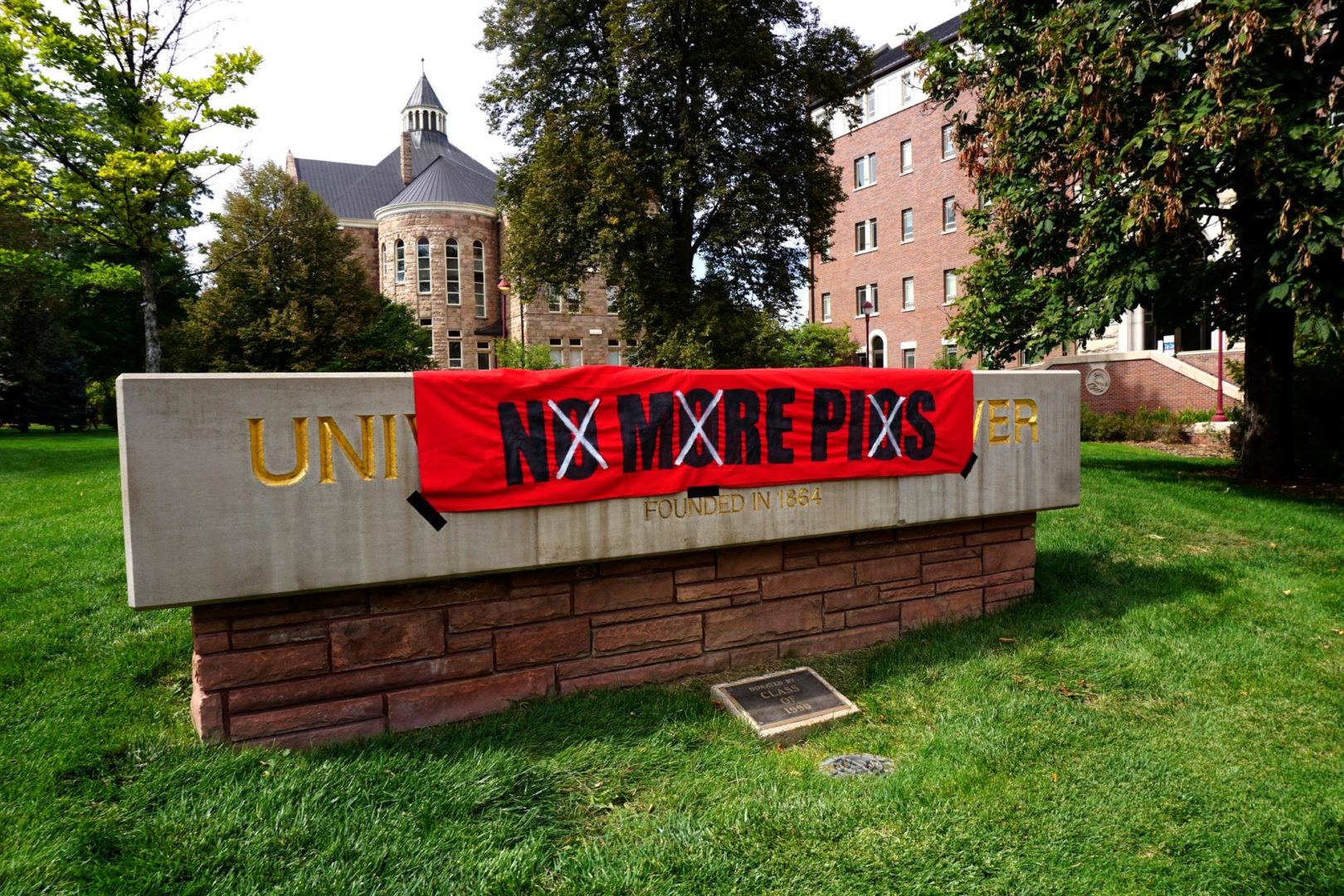
“[Pioneer] glorifies imperialism and colonization,” A protestor who wished to remain anonymous said on Friday. “It highlights everything that is wrong with how we, white people, came to this country. The name is a disgusting smear on Indigenous people.”
R.A.H.R. organizers have tried the traditional channels of reform to push #NoMorePios. They have found these efforts disheartening.
“The chancellor often tells us that he’s thankful we’re doing this work for the University,” said third-year Blake Nordstrom-Wehner, another one of the organizers. “He tells us, ‘I’m so glad you have done this. I’m so proud of you.’ Yet, almost all of this labor is ignored and unpaid. He is aware enough to thank us, but he doesn’t go beyond that to credit or acknowledge student activists.
#NoMorePios is one of seven action items outlined by R.A.H.R. The full list includes:
- The establishment of a Critical Race and Ethnic Studies (CRES) department
- Engagement with Native communities through scholarships, mentorship programs, etc.
- Reconstitution of the Native American Advisory Board
- Increased hiring and retention of faculty of color
- Divestment from any and all ties with ICE
- A seat for students on the Board of Trustees
It draws heavily from the list of demands made in 2016 by Black Lives Matter (BLM) protestors. R.A.H.R organizers felt that now was the time to bring these back to the forefront of DU’s consciousness, as both the university and nation are experiencing a time of transition and unrest.
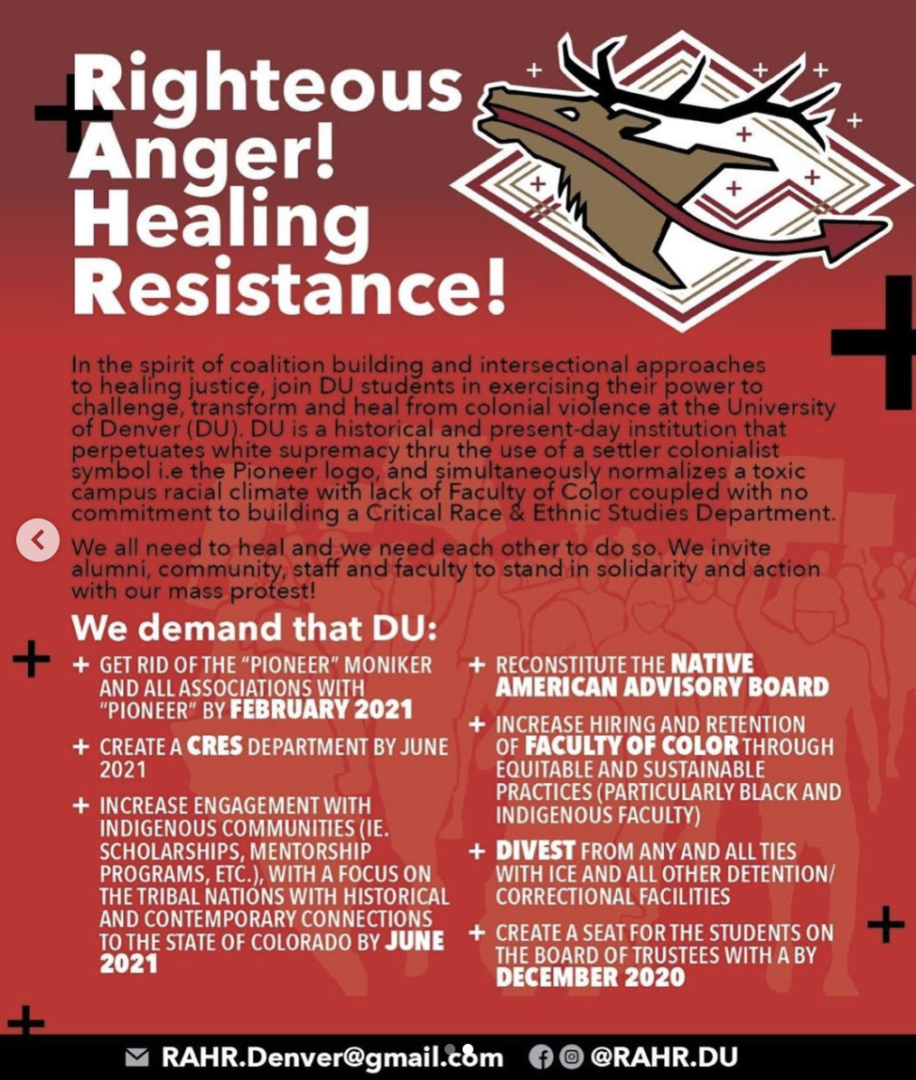
“We wanted to create a space where colonized communities can be, heal and revolt together,” said fourth-year organizer Maya Bhowmik.
The decision to hold this protest in the midst of a pandemic was a contentious one. Three days before the action, DU administration informed R.A.H.R. that students may be given DU Honor Code violations as well as Location Restrictions for attending. The school cited its COVID-19 protocol as justification.
The organizers expressed frustration with this development. Masks and social distancing were required for the event. Hand-sanitizer would be readily available. Statistics have proven that Colorado protests held outside do not lead to spikes in COVID-19 cases. Yet still, they had been told to expect punishment.
In response, R.A.H.R. made this statement: “We will not be silenced. See you in the streets.”
Third-year organizer Caris Fox explains that, “DU’s COVID-19 protocols don’t make a distinction between a house party and protest, even though the two are very different. A house party is for fun, while a protest has a purpose. We do this to change our institution and empower our communities.”
Soon after R.A.H.R. put out its statement and two USG Senators published a Letter to the Editor with the Clarion, the Chancellor sent an email reaffirming “DU’s commitment to free speech” and clarifying that disciplinary action would only be taken “if the health and safety of the DU community was endangered.”
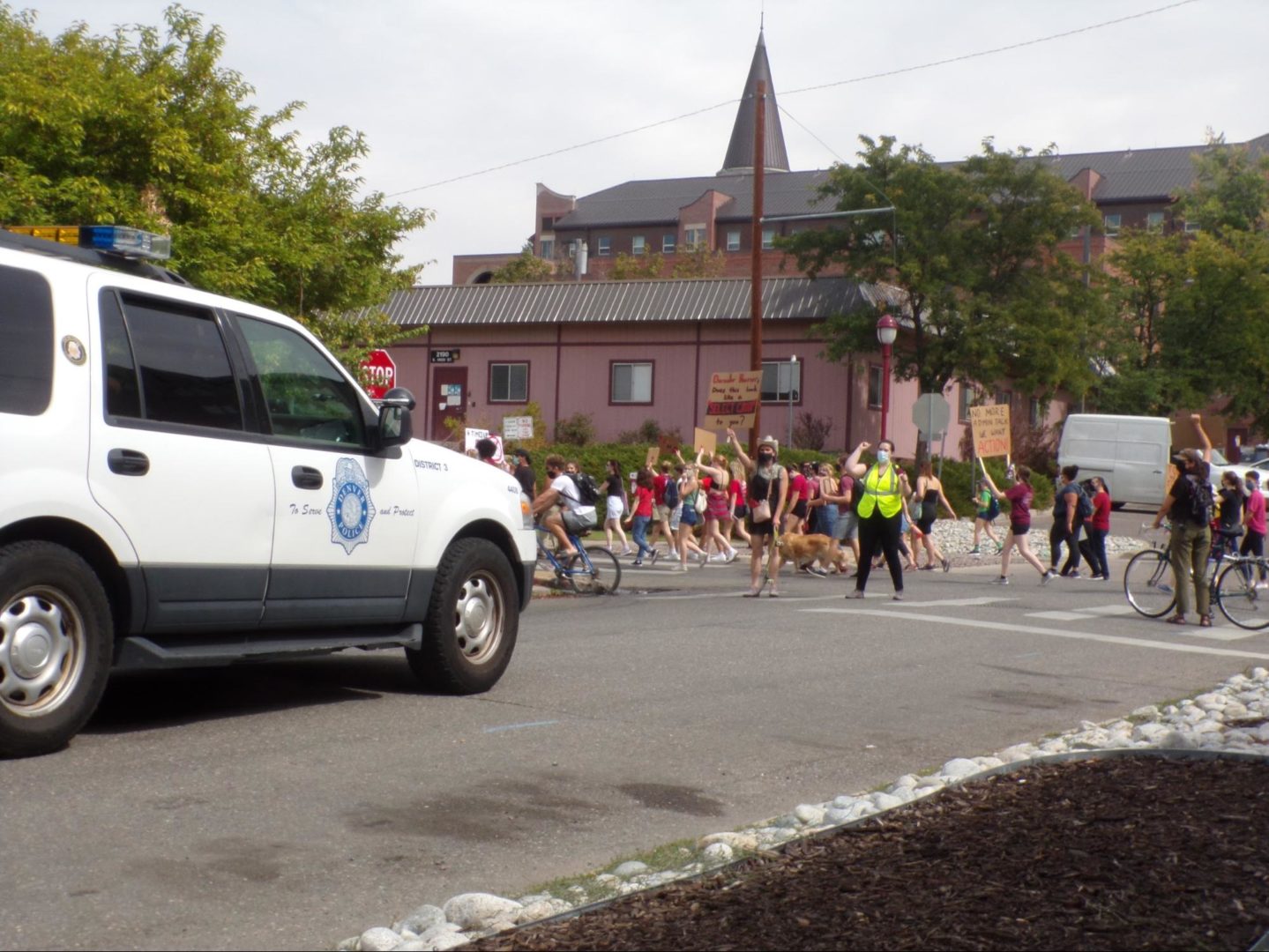
On Friday, Dr. Sarah Watamura—DU’s COVID Response Coordinator—made periodic appearances on the green. Her presence served as a reminder of the threat made by the DU administration several days earlier.
“There has never been a more important moment to be allied with the communities of color this school is allegedly so proud to have,” said Marcos Descalzi, a recent alumnus and protestor at the event. “[DU] should have done right by them in the first place and encouraged these protests to happen.”
To accommodate those who were not comfortable attending in-person, R.A.H.R. made the protest hybrid. At several DU-approved locations on campus, students could listen to the event’s audio in limited capacities. On Facebook, the event was live streamed. Additionally, while the march remained around the perimeter of campus, organizers changed the location for the rally afterwards to Observatory Park.
This action pushed for an institutional shift in power, but it also recognized the state of this country’s racial climate at large. After consulting with the Native Student Alliance on campus, the organizers decided to take an intersectional approach and stand in solidarity with movements such as BLM and Abolish ICE.
“These systems benefit off marginalized groups, and DU is an example of that,” Mary Kudoadzi, fourth-year and R.A.H.R. organizer, said. “A lot of us graduate without anything to show for this work. But we do it because we have to and know our activism will eventually benefit someone. BLM holds this same idea—we fight for the people after us, like those before us did.”
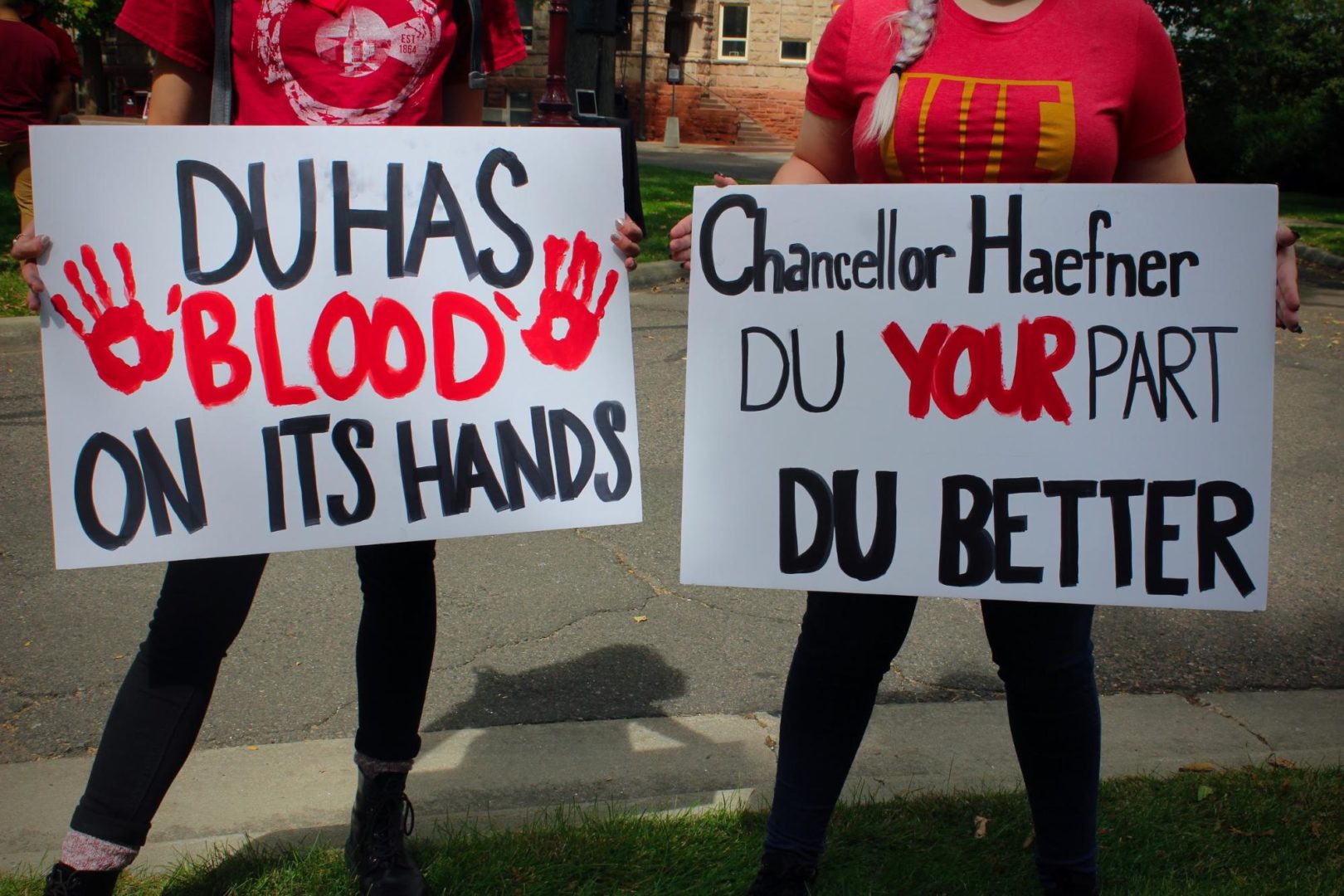
Protestors carried this passion and sense of community from Mary Reed Hall, around the perimeter of campus, to Observatory Park. There, virtual and live speakers from diverse backgrounds touched on the significance of activist spaces as places of both healing and resistance. This is a framework commonly used in critical race theory, and R.A.H.R. hopes student activists will employ it beyond this protest.
“When communities engage in activism, there is a negative connotation that we are perpetuating hate,” IRISE professor and scholar Johnny Ramirez said. “But our work comes out of a place of love and demand for justice.”
At present, R.A.H.R. does not have further actions planned. However, they encourage student activists to hold the university accountable to these demands as well as support the work of Diversity Committee and Remember X. Organizers will continue to be present and involved on campus, albeit in more structured spaces.
R.A.H.R’s work does not begin or end with this protest. Whether in classroom or protest environments, #NoMorePios continues to gain momentum and acknowledgement.
For their flyers, R.A.H.R. asked permission to use a visual created by DU’s Native Student Alliance. The skoden is a proposed alternative to the university’s ‘Pioneer’ moniker. This type of elk almost went extinct in the 1900s but are bountiful today in Colorado. It is a symbol of resistance for Indigenous communities such as the Cheyenne and Arapahoe, fostering leadership, wellbeing and warriorship.
Last Friday, its spirit was felt.









